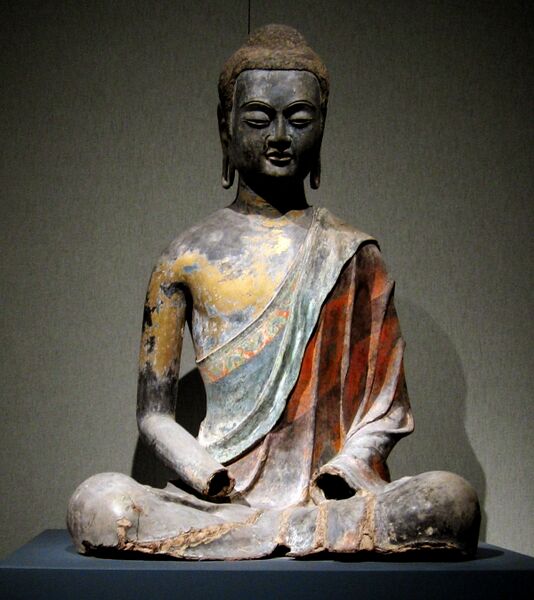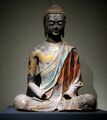Файл:Mahayanabuddha.jpg

Исходный файл (1199 × 1347 пкс, размер файла: 651 Кб, MIME-тип: image/jpeg)
Описание
| Описание | Seated Buddha, probably Amitabha (Amituo). Buddhist images executed in dry lacquer were highly valued by the Chinese because of their costly and time-consuming process of production. There are so few surviving examples that this seated Buddha is especially precious. To fashion the body of the image, the craftsman made a rough form of the sculpture in clay and then applied at least three layers of hemp cloth, each secured with a paste made of raw lacquer (the sap from the lac tree, Rhus verniciflua) and a fine powder of bone, horn, shell, ceramic, stone, or carbon. Each layer had to dry thoroughly before the next could be added. The clay core was then removed from the lacquered image. The head and hands were likely modeled separately, using the same technique as that used for the body, and then attached to the sculpture. The surface was finished with several coatings of pure lacquer and then painted. Portrayed as a youthful figure, the Buddha sits in the full lotus position, with his legs tightly interlocked, though the lower part of the sculpture is missing. The position of the damaged arms suggests that the hands performed the "contemplation" gesture.
The columnar form and lean gracefulness of the figure recall the style of Buddhist sculptures of the late Six Dynasties, but the attempt to render anatomical differentiation and, in particular, the emotional impact of the Buddha's expression are distinguishing features of early Tang style. The traces of brilliant red and blue, vividly combined to form a stylized floral pattern in the hem of the undergarment crossing the chest, and the remains of shimmering gilt on the surface are evidence of the sumptuous effect of this once colorful figure. |
|---|---|
| Источник | https://www.flickr.com/photos/rosemania/86745965/in/set-72057594048518296/, Photograph by Rosemania |
| Время создания | early 7th century (Tang Dynasty) |
| Автор или правообладатель |
Unknown author — Лицензия: CC BY 2.0 (Creative Commons Attribution 2.0) https://creativecommons.org/licenses/by/2.0
|
| Другие версии файла | — |
Источник файла — сайт Wikimedia Commons, куда он был загружен под одной из свободных лицензий ( https://commons.wikimedia.org/wiki/File:Mahayanabuddha.jpg ). Авторов, работавших над этим файлом см. в истории файла: https://commons.wikimedia.org/w/index.php?title=File:Mahayanabuddha.jpg&action=history
В общем случае в статьях энциклопедии Руниверсалис файлы используются в соответствии со статьёй 1274 Гражданского кодекса Российской Федерации.
История файла
Нажмите на дату/время, чтобы увидеть версию файла от того времени.
| Дата/время | Миниатюра | Размеры | Участник | Примечание | |
|---|---|---|---|---|---|
| текущий | 04:00, 15 августа 2023 |  | 1199 × 1347 (651 Кб) | Я, робот (обсуждение | вклад) | == Описание == {{Изображение | описание = Seated Buddha, probably Amitabha (Amituo). Buddhist images executed in dry lacquer were highly valued by the Chinese because of their costly and time-consuming process of production. There are so few surviving examples that this seated Buddha is especially precious. To fashion the body of the image, the craftsman made a rough form of the sculpture in clay and then applied at least three layers of hemp cloth, each secured with a paste made of raw lacq... |
Вы не можете перезаписать этот файл.
Использование файла
Следующий файл является дубликатом этого файла (подробности):
- Файл:Mahayanabuddha.jpg из на Викискладе
Следующие 2 страницы используют этот файл: